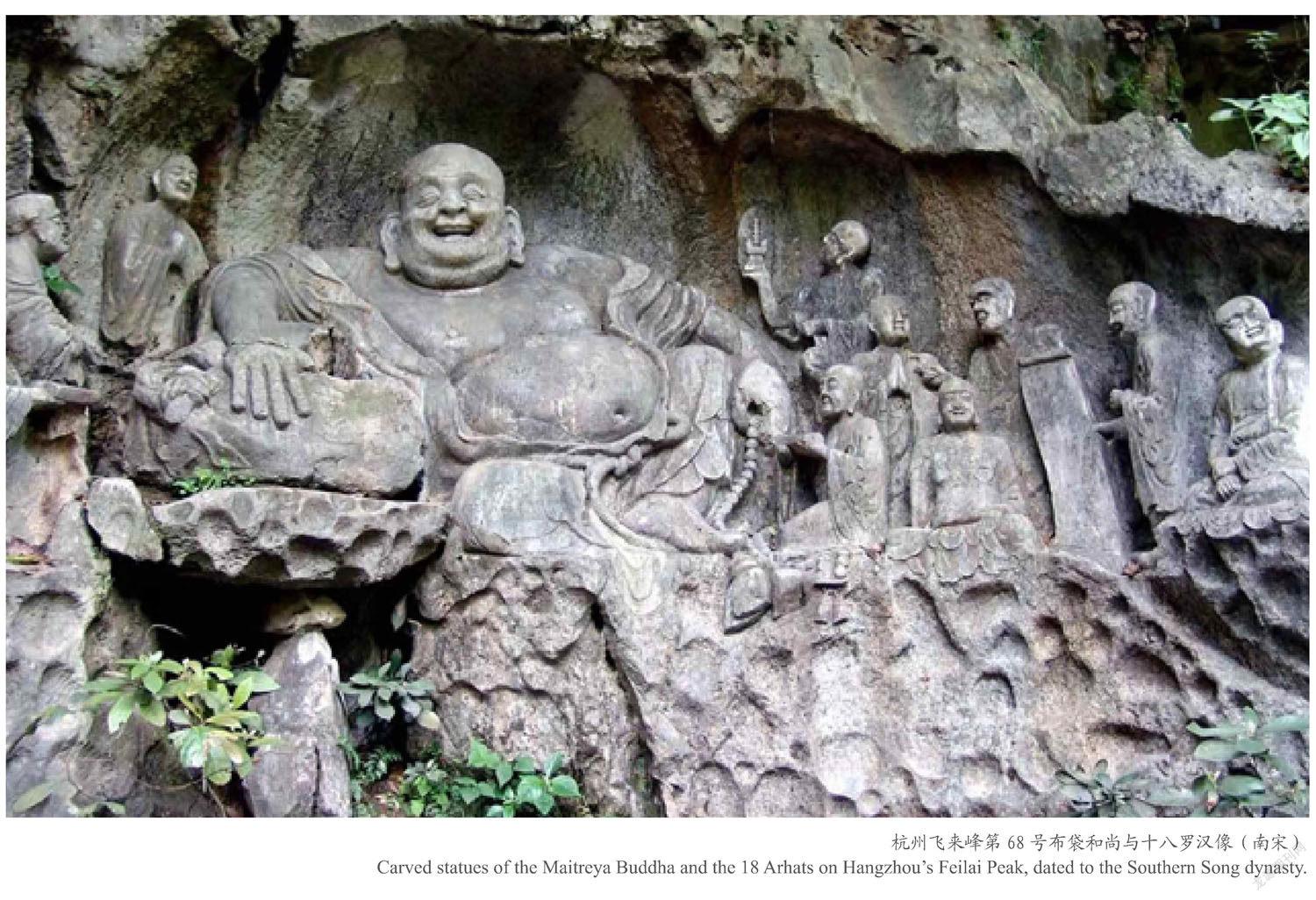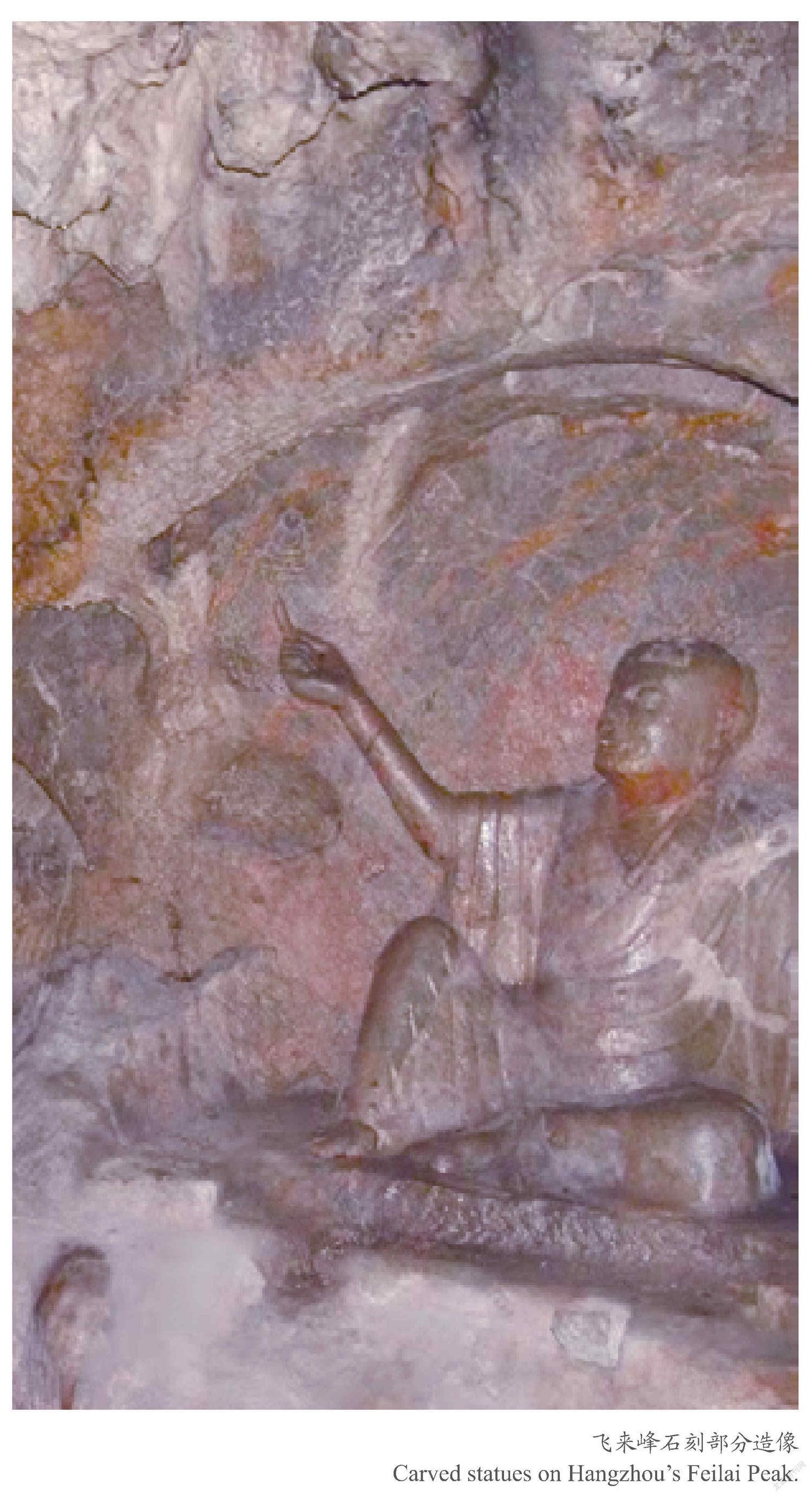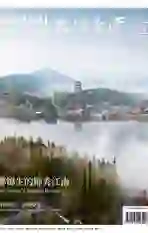杭州的宋代石窟有多厉害?
2022-03-28李俨娇
李俨娇




中国是世界上石窟寺保存数量最多、时间跨度最大的国家。这些雕凿于崖壁间的不朽精灵,穿越千年的时光,历久弥新——
甘肃敦煌莫高窟、山西大同云冈石窟、河南洛阳龙门石窟、甘肃天水麦积山石窟等四大石窟,皆是以中国佛教文化为特色的巨型石窟艺术景观。
杭州的石窟,也占有一席之地。通过它们,我们能从中感受到古代工匠震撼人心的精湛技艺,窥见中国古代社会的世俗日常与人间烟火。
常青与杭州飞来峰之缘
近日,由四川大学艺术学院教授常青撰写、浙江古籍出版社出版的《中国石窟简史》读书会,在杭州晓风 · 明远book举行。在这场以 “杭州宋代石窟造像的主要成就”为主题的读书会上,常青向在场读者和通过直播观看的网友们展示了杭州宋代石窟造像的独特魅力,以及杭州造像题材对中国乃至整个东亚地区的重大贡献。
新疆、甘肃、陕西、山西、河北、河南、四川、浙江、江苏……专业从事中国佛教艺术研究的常青,去过国内所有著名的石窟。但杭州,依然给他留下了深刻的印象,尤其是杭州宋代石窟造像的魅力,以及与杭州飞来峰石窟之缘分,让他至今说起来依然是滔滔不绝。
“杭州是全世界最漂亮的城市”。常青说,他有20多只珍藏的档案袋,这20多只袋汇成一部“中国石窟简史”。
几只牛皮纸档案袋,封面手写“资贤寺摩崖造像”“宝成寺”等。将近24年后,常青终于打开了这些袋子。
那是2017 年左右的事情了。
那天的读书会上,常青说起了这些档案袋的故事。陪他走过40多年的袋子里“珍藏”的石窟造像,有的已经消失,有的渐渐变老。好在袋子里的数据、测繪、照片永远不会改变,它们汇成了一本“简史”:中国石窟简史。
“我一直喜欢石窟。”
1990年,北京大学考古系硕士研究生常青,结束了在龙门石窟研究所三年的实习工作。他和他的导师、著名考古学家宿白聊起这里的见闻和发现。
宿白说,有机会的话,你就往外走。
论文答辩,对面坐着答辩委员会主席徐苹芳——著名考古学家。1983年和1987年,中国社会科学院考古研究所与地方文物部门合作,先后组建了临安考古队和扬州考古队,徐先生任队长。1991年至1993年,常青在杭州参与了临安城遗址的考古发掘。
常青知道杭州有很多石窟,跟队长李德金说 :我能不能利用周末时间调查一下石窟?李德金说可以。他又跟徐苹芳汇报,我想对石窟调查一下,因为我一直喜欢石窟。
去中国社科院考古所报到时,徐苹芳对他说,我们没有石窟调查的工作,都是考古发掘的工作,你必须得参加一个队。常青说,我不喜欢写考古发掘的文章,要写文章,我还是写石窟的。徐苹芳说 :好。
毕业后,虽然不再做田野发掘,但田野考古的研究与考察方法,深深影响着常青对石窟寺的研究。考古学的断代方法,主要是依据地层的叠压与打破关系。这种关系也往往可以在石窟寺的雕刻与壁画中见到,完全可以用来为石窟寺断代。正是利用这种方法,常青写成了对炳灵寺169窟塑像与壁画分期的文章。炳灵寺石窟第169窟,是我国目前所知最早的一个纪年洞窟(420年)。
这是他第二次来杭州,第一次来是三年前,去了飞来峰。
太漂亮了,和他在北方看到的石窟完全不同,他隐隐知道,如果将来要研究飞来峰,那是另一个完全不同的体系,在常青眼中,那是与北方石窟完全不同的漂亮。数年后,他的博士论文的研究对象正是杭州飞来峰造像。
“三个最早”罗汉造像与杭州之缘
在读书会上,常青说,“杭州是我的第三故乡”。在杭州石窟造像中,常青多次强调最重要当数飞来峰造像。它的地位,可以用三个“最早”来形容——
现存最早的五百罗汉造像。五百罗汉,唐代以后,在全国各地均有流行。常青认为,五百罗汉的起源地可能就在杭州。相传吴越钱镠曾在天台山建五百罗汉殿,这是文献记载最早的五百罗汉造像,可惜早已无存。虽然杭州飞来峰青林洞的罗汉造像只有120余尊,但却是目前较完整地保存下来的最早的五百罗汉造像,从很多造像题记中可以看出,其塑造年代在北宋,基本完成于1000—1003年。
现存最早的一组石雕十八罗汉像。十六罗汉,主要依据唐玄奘翻译的《法住记》,流传于唐代,后来中国人又创造了两位罗汉,形成十八罗汉。杭州飞来峰烟霞洞内,保存有我国现存最早的一组石雕十八罗汉像。长期以来,对于十八罗汉的名字众说纷纭,烟霞洞内的这组罗汉像多带有题记,对于十八罗汉名称可谓起到了正本清源的作用。
全国最早的布袋与十八罗汉造像。飞来峰的标志——雕刻于南宋时期的布袋和尚与十八罗汉造像,是全国最早的、公认最好的,同时也是全国唯一的布袋和尚与十八罗汉造像。这里也是杭州很多“80后”小时候的打卡地点。
实际上,杭州的石窟造像均雕凿于唐代以后,主要完成于公元10至14世纪的五代、宋、元时期。它们虽不及龙门、云冈、敦煌等地的石窟那样宏伟与年代久远,却是研究中国10世纪转型期以后佛教艺术史不可或缺的重要资料。
“如果我们说,不能全面掌握杭州造像,就无法真正了解中国10世纪以后佛教艺术的发展脉络,也绝不是夸张之辞。”常青说,这是由杭州在中国晚期佛教史上的重要地位决定的。杭州曾是五代十国时期佛教最为发达的吴越国的首都,宋代最大的佛教宗派禅宗的中心,第二大宗派天台宗的两个中心之一,在宋代复兴的华严宗的中心,也是元代江南佛教的中心。
杭州历史地位的重要性,决定了它的造像艺术在五代宋元时期的重要性,决定了它在题材、图像、风格方面必然对其他地区产生过或多或少的影响。也正是这样崇高的地位,决定了宋代杭州城内分布有很多寺院,寺院中保有众多珍贵的艺术品。遗憾的是,这些艺术品今天大部分都已湮灭,人们能看到的,只有保存在西湖周边群山中的石窟造像。
除了飞来峰,杭州现存南宋造像还集中在宝石山、将台山南观音洞、栖霞岭黄龙洞、紫阳山开宝仁王寺。杭州有南宋纪年的造像,则仅存于南观音洞。
除了已提及的飛来峰南宋大肚布袋和尚像,杭城中的另一个著名标志,就是仁王讲寺遗址。开宝仁王寺(又称仁王讲寺)摩崖造像位于杭州市上城区紫阳山南麓白马庙巷内,坐北面南依石崖雕就,是原寺院的一个组成部分。这里原来有一座开宝仁王寺,是继承了北宋首都东京汴梁开宝寺的仁王院于绍兴五年(1135年)在杭州兴建而成的,主要服务于南宋皇室。如今寺院已经没有了,只留下三龛造像。
常青说,石窟艺术史上很多的题材,比如唐以后流行的很多题材,在杭州发现得最早。如十八罗汉、五百罗汉……或许这些题材原本就在杭州起源,然后再扩散到全国。
作为宋韵传播智库成员的常青,他对石窟的研究一直在路上,中国重要的石窟造像他几乎全部跑遍。当年的20多个有关石窟考古的袋子,一个个打开了,接下来,常青说“也就是说,第一手调查资料基本都用完了,现在,我需要新的调查。我经常想,我这一辈子到底什么是最大的快乐?我想,似乎都是在盼望着哪一天我去哪看看。”
The Magnificence of Hangzhou’s
Song Dynasty Grottoes
By Li Yanjiao
Collectively known as the “Four Great Grottoes” in China, the Mogao Grottoes in Dunhuang, Gansu province, the Yungang Grottoes in Datong, Shanxi province, the Longmen Grottoes in Luoyang, Henan province, and the Majishan Grottoes in Tianshui, Gansu province feature distinct Buddhist art and culture, as well as giant caves and statues.
In fact, China holds the largest number of cave temples in the world, with the longest historical span.
While not as famous as those four, Hangzhou is also a major site when it comes to ancient caves, through which we can get a glimpse of the stunning skills of ancient craftsmen, and the daily life of ancient Chinese society.
At a recent event held in Hangzhou’s Xiaofeng Bookstore, Professor Chang Qing of the Arts College of Sichuan University introduced the unique charm of the Song dynasty (960-1279) grottoes in Hangzhou to both onsite readers and those who watched through live streaming, as well as the great contribution the statues in these grottoes made to China and even the whole East Asia region.
The event, themed “Major Achievements of Song Dynasty Caves and Statues in Hangzhou”, focused on Chang’s new book A Concise History of Grottoes in China, published by Zhejiang Ancient Books Publishing House.
From Zhejiang to Xinjiang, from Gansu to Jiangsu, from Shanxi to Shaanxi, from Hebei to Henan, and Sichuan where Chang teaches, he has visited all the well-known grottoes in China. Indeed, Chang has amassed so much materials on the grottoes he has been to that he has deposited them — survey data, maps, photos — into more than 20 archive bags, culminating in a final product A Concise History of Grottoes in China.
For Chang, who specializes in the study of Chinese Buddhist arts, Hangzhou, as well as its striking Buddhist caves and statues, left an indelible mark.
“I have always been fascinated by grottoes,” Chang said.He was enrolled in the prestigious Peking University in 1981, majoring in archeology for his undergraduate studies before pursuing a master’s degree in the same subject at the university. After graduation, Chang first worked at the Longmen Grottoes Institute and then joined a team of archaeologists for the excavation of the ruins of Lin’an city, capital of the Southern Song (1127-1270) between 1991 and 1993.
It was during this period that Chang began to study the many Buddhist caves located around Hangzhou’s Feilai or Flying Peak in his spare time. To Chang, the beauty and appeal of these caves, and the statues, sculptures and paintings in them, were entirely different from those he had seen in northern China. At the time, he already had the vague idea that if he were to conduct in-depth research on them, he would also resort to a drastically different system, as opposed to how he studied their northern counterparts. Years later, Chang’s Ph.D. dissertation would actually focus on the statues and sculptures in these caves.
“Hangzhou is the most beautiful city in the world,” Chang said. “It is also my third hometown.” While the Buddhist statues on the Feilai Peak are not the only ones dating back to the Southern Song dynasty — there are also those on the Baoshi Hill, Jiangtai Hill and Ziyang Hill, they are the most important ones in Hangzhou. Their importance is characterized by a number of “earliest”, according to Chang, who is also a member of the recently established think tank dedicated to the popularization of Song dynasty culture.
First, the earliest surviving statues of the “500 Arhats”. The images of 500 Arhats started to gain popularity after the Tang dynasty (618-907), and they may well have originated in Hangzhou. Indeed, many themes in the history of grotto arts, such as those popular after the Tang dynasty, were first discovered in Hangzhou, and Chang believed that they were first born in Hangzhou before spreading across the country.
According to historical documents, Qian Liu (852-932), founder of the Wuyue kingdom (907-978) built a hall housing the 500 Arhats in the Tiantai Mountains, the earliest written record of the 500 Arhats statues. Unfortunately, they have long disappeared. Although only 120 of the 500 Arhat statues survive in the Qinglin Cave of the Feilai Peak, they are the earliest ones that have been well preserved. The inscriptions on these statues indicate that they were sculpted in the Northern Song dynasty (960-1127), completed roughly between 1000 and 1003.
Second, the earliest surviving stone statues of the “18 Arhats”. Followers of the Guatama Buddha, the “18 Arhats” were originally 16, who became known in the Tang dynasty, after the monk Xuanzang (602-664) translated Fa Zhu Ji, or Record on the Duration of the Law, Spoken by the Great Arhat Nadimitra, into Chinese. The number was increased to 18 later. In the Yanxia Cave of the Feilei Peak is a group of China’s earliest “18 Arhats” statues. For a long time, opinions differed as to the names of the arhats, and the inscriptions on these statues have offered invaluable evidence.
Then, the earliest statues of the Maitreya Buddha (Laughing Buddha), carved during the Southern Song dynasty (1127-1279), can also be found in the Feilai Peak.
In fact, the grottoes in Hangzhou were carved after the Tang dynasty, largely during the 10th to the 14th centuries. While not as grand and ancient as the grottoes in Longmen, Yungang and Dunhuang, they are indispensable to studying the transition of China’s Buddhist arts after the 10th century.
“It is no exaggeration to say that if we cannot fully understand the Hangzhou statues, we cannot truly understand the development of Buddhist arts in China after the 10th century,” said Chang. As the capital city of the Wuyue kingdom, where Buddhism was most dynamic at the time, Hangzhou was also the center of Chan (Zen) Buddhism in the Song dynasty, one of the two centers of the Tiantai sect, the center of the Huayan sect as well as the center of Buddhism in Jiangnan (south of the Yangtze River) in the Yuan dynasty (1206-1368).
Hangzhou’s historical status means that it has more or less influenced the other regions in terms of themes, images and styles when it comes to Buddhist statues and sculptures. Although there were numerous monasteries and temples in Hangzhou during the Song dynasty, in which were housed many precious works of art, unfortunately, most of them have been lost, and only the cave statues in the mountains surrounding the West Lake have been preserved.
“My first-hand investigation materials are basically used up,” said Chang, referring to the 20-odd archive bags he had collected. “Now, I need a new investigation. I often wonder what is the greatest happiness in my life? I guess it is the expectation of where I’m going to next.”
